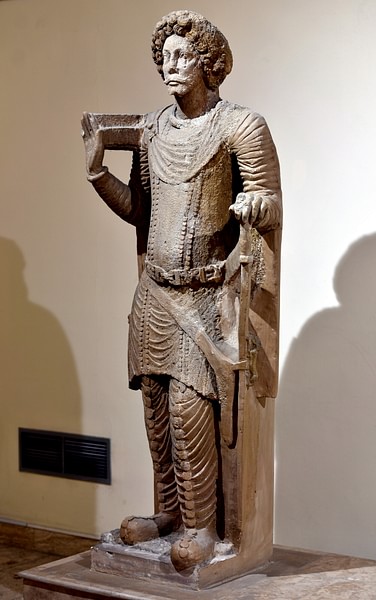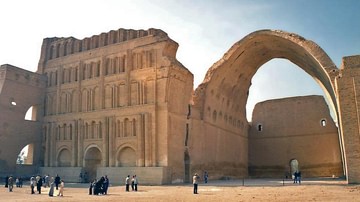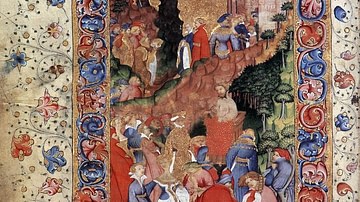
The Parthians ruled from 247 BCE to 224 CE creating a vast empire that stretched from the Mediterranean in the west to India and China in the east. East of the Caspian Sea there emerged from the steppe of Central Asia a nomadic Scythian tribe called the Parni. Later called the Parthians and taking over the Seleucid Empire and fending off the Romans, they established themselves as a superpower in their own right. With a unique and extremely successful fighting style, the vast area they conquered put them in contact with goods and cultural influences from different parts of their empire. From these influences, the Parthians not only blended architectural styles to make their own Parthian architecture but they also created their own unique Parthian art and dress.
Parthian Expansion
The story of Parthia begins with Seleucus I, one of Alexander the Great's generals. After Alexander's death, his generals divvied up the conquered territories. Seleucus took Mesopotamia and other districts once central to Persia, creating the Seleucid Empire. Incorporating Greek infrastructure and administrators, Seleucus adopted Persia's form of governance. With districts or satrapies headed by satraps (governors) beholden to a central government and ultimately the king, Parthia became one of those satrapies. But Parthia as a Seleucid satrapy would soon become its own empire.
In the infancy of its political history, the Parthian satrapy was located southeast of the Caspian Sea. Thought to be related to the Scythian culture of Central Asia, the nomadic Parni tribe eventually came to control Parthia. While the Seleucids were weakened by internal war and conflict with the Ptolemies in the west, the Parni made their move in the east. The door opened for the Parni in 247 BCE when the local governor Andragorus started a rebellion against Seleucid rule. Knowing the Seleucids were distracted, and Andragorus was weak, Arsaces (r. 247-217 BCE), Parthia's first king, conquered Parthia. Wanting Parthia back, the Seleucid ruler Antiochus III would retake it in 209 BCE. By this time Arsaces' son, Arsaces II (r. 217-191 BCE) was on the throne. Antiochus could have killed him but, instead, he set him up as satrap. That may have been a mistake.
After Antiochus left to go back to Syria, the Parthian elite, disgruntled at their subordination, deposed Arsaces II and set up Phriapatius (r. 191-176 BCE) as their third king. As circumstances again favored the Parthians, with the reduction of Seleucid might by the Treaty of Apamea with the Romans in 188 BCE, Phriapatius' son, Phraates (r. 176-171 BCE) attacked the Seleucid empire. By conquering the Amardians, Phraates gained the region between Hyrcania in the east and Media to the southwest. In this way Phraates got the ball rolling for Parthia, but selecting his brother, Mithridates (r. 171-132 BCE) to succeed him, would result in Parthia's greatest expansion.

Mithridates right away turned east to conquer Bactria—India and China's neighbor—around 168 BCE. Then, wanting to add to Phraates' gains, he turned west toward Media. Meeting stiff resistance in a nine-year war, Media was finally added to Parthia's growing territorial advance in 151 BCE. After a four-year hiatus back at Hyrcania, possibly to reboot his military, Mithridates thought the time was ripe to look even further west toward the all-important fertile crescent area of the Euphrates and Tigris rivers known as Mesopotamia. C. 144 BCE he captured Seleucia, the former Seleucid capital. In 141 BCE he took Babylon. Able to fend off Demetrius II's campaign to retake Seleucid territory in 138 BCE, Mithridates then turned south to take Elamite country and the capital city of Susa. Wanting their territory back, the Seleucids again struck back at the Parthians. Mithridates' son, Phraates II (r. 132-127 BCE) would kill the Seleucid ruler Antiochus VII in battle but would die trying to put down a Scythian mutiny. After the death of Phraates II, uprisings in Parthian territory abounded. Would the fabric of their empire now unravel? Artabanus I and his son Mithridates II would play crucial roles.
Uncle of Phraates II, Artabanus I (r. c. 127-124 BCE) would successfully put down revolts in Elam, Characene, and Babylon, but his reign was cut short when he was killed in battle against the Yuezhi in the east. His son, Mithridates II (r. 124-88 BCE) would take over and become Parthia's greatest ruler. Mithridates would not only strengthen Parthia's hand in Elam, Characene, Mesopotamia, and Bactria but he also added Albania and Armenia and captured the Syrian city of Dura-Europos in the west. With frontiers now stretching between the Mediterranean Sea and China, Parthia became a geographical juggernaut and true superpower.

The Parthian Empire would experience some serious challenges again; this time from Rome. Phraates III (r. 70-57 BCE) would lose Armenia, Albania, and Gordyene in northern Mesopotamia to the Romans, causing his sons to assassinate him. After civil war broke out, when Orodes II (r. 57-37 BCE) killed his brother Mithridates III and reconquered the capital city of Seleucia, the time was ripe for Parthian victories. In 53 BCE, Crassus, the Roman triumvir, invaded Parthia near Carrhae. Orodes sent his general Surena to deal with the matter. With overwhelming use of Parthian archers on horseback, Crassus was utterly defeated, and the Roman standards were taken; a huge psychological blow for Rome. Then, to top it off, the Parthians regained Armenia with the defeat of Mark Antony in 32 BCE. These two defeats brought Rome to the negotiating table. To avoid a continuation of a conflict that would significantly weaken footholds already gained by each side, a treaty was made allowing the Parthian Empire to eye gains toward the east. As Raoul McLaughlin aptly states:
In 20 BCE Augustus secured a long-term peace agreement with the Parthian King Phraates IV. This agreement allowed both rulers to concentrate their military activities on other frontiers and thereby enlarge their respective empires. (181)
Parthian Military Tactics
Key to many a Parthian victory and the expansion of the Parthian Empire was the unique use of the horse and bow. With a hit and run fighting style, Parthia's tactics (including pretending retreat) were well suited to counter the concentrated troop movements of other nations. With archers on the fleetest of horses, and camel riders providing a steady supply of arrows, they made sitting ducks of infantry unable to engage except at close range. When the enemy's cavalry gave chase, the Parthians had an answer. So adept at their lethal craft, they developed the 'Parthian shot'. Able to shoot backward from horseback at full gallop, the Parthian archer delivered kill shots at pursuing cavalry. Thus, Parthian horsemen were able to come at enemy troops from all directions, creating confusion and wreaking havoc. Finally, their heavily armored cavalry (cataphracts) provided offensive support and assistance in mopping up remaining pockets of resistance with long lances and swords.
Parthian Government
Parthia's form of government was an amalgam of practical answers to local needs. Rulership from the top was never in doubt. The "king of kings," as later Parthian rulers called themselves, demanded absolute loyalty, but Parthia's practical sense of government is indicated right off the bat when Mithridates I kept Greek nobles in positions of leadership to ensure a continuance of economic and bureaucratic affairs. Mithridates, in fact, referred to himself as "Philhellene" or "lover of Greek culture." Greek settlements throughout the empire were left alone as long as they paid tribute to the king.
Moreover, the rebellions experienced by the Seleucids were avoided by dividing their provinces into smaller satrapies called eparchies. This eliminated the concentration of regional power in the hands of one person. The Parthians also allowed conquered kingdoms within their empire to have their own kings. This provided income from tribute and military assistance when needed.
Economy & Trade
With the Romans held at bay, Parthia could try their hand at trade. As Richard Frye mentions:
The small states in the Fertile Crescent, which favored the decentralized 'feudal' form of government of Parthia, developed greatly as mercantile centers of international trade. The first two centuries of our era was an age of commerce, and the oasis states of the 'Fertile Crescent' flourished as never previously. (18)
The Parthians' commercial development started with the infrastructure they inherited from the Seleucids. They wisely preserved the cities and roads they received. Their possession of Armenia and possible access to the Black Sea and control of Hyrcania and the Caspian Sea gave them access to Central Asian markets. Their takeover of Persis and cities like Antioch-in-Persis on the Persian Gulf meant access to Indian markets by way of water. Their control of Elam and the politically important city of Susa, and the fertile region of Media and its wealthy city Ecbatana would have enriched the Parthians culturally and materially.

One of Parthia's most prized processions would have been the Royal Road. Running east and west through Mesopotamia, this highway solidified Parthia's position as an international trader—with it came Bagdad and Seleucia as gateways to the west. Then stretching east to include Bactria, a neighbor of India, access to eastern markets were now direct and lucrative. Finally, trade with China was a real possibility. According to Wang Tao,
We now know that, as early as the third millennium BCE, a network [of roads] already existed in the Eurasian steppe land, stretching from the Caspian Sea in the west, to the Tarim Basin in the east. (87)
With the expansionist policy of the Han Dynasty of China, contact with the west was made. According to Chinese chroniclers, Chinese envoys visited Parthia in 115 BCE. The exchange of token trade items between the Parthian king and the Chinese representatives may have set a precedent for broader trade deals in the future.
Parthian Architecture & Art
Due to their empire's location, and their origins in Central Asia, the Parthians had as their source a wide range of influences when it came to art and architecture. Daryoosh Akbarzadeh describes Parthia in this way:
Archaeological evidence testifies to the greatness of the culture and art of the Parthian era. The cultural heritage associated with this era has been discovered over a vast expanse, from the borders of China and Central Asia, all the way to Mesopotamia and Syria in the west. (76)
Some scholars have surmised Parthia's departure from Hellenistic influences was because of its competition with Rome. Either way, unlike the Seleucid Greeks, the Parthians developed their own unique artistic and architectural style. Borrowing from the east and west, theirs was an amalgam easily identified as Parthian. Their architecture and art employed, respectively, interesting circular and frontal motifs.
Architecturally, the Parthians left in place existing structures that under the Seleucid Greeks naturally copied the Hellenistic rectangular layout with colonnaded and triangular features famously known and still reproduced in the west today, but where they could, the Parthians sought to be different. On entrance to a Greek or Roman temple, one passes through a portico of columns. Entering the Parthian temple at Hatra, one arrives under the eye of graceful arches. The blend of Greek-style columns and triangular pediments with multiple Parthian arches at Hatra gives the temple its unique curbside appeal. At Parthian Assur, the use of Parthian arches is again prominently featured. But the use of circularity as an architectural feature during the Parthian period is pronounced in other ways.

Reminiscent of the absolute circular Chorasmian fortress at Koi Krylgan Kala (c. 400 BCE - 400 CE) east of the Caspian Sea, whole Parthian towns and fortresses were also laid out in circular fashion. Comparing Seleucid and Persian rectangular planning to some Parthian sites, Malcolm Colledge says:
A very different approach to planning was represented by the vaguely circular shape of several cities under Parthian control or influence, the Parthian re-foundation of Ctesiphon, and the ramparts around Carrhai, Takht-I Suleiman and Hatra of about the first century A.D. were more closely and deliberately, circular. (34)
At Nisa, their original capital, the Parthians again chose circularity as a prominent architectural feature. There, Parthian architects built a dome that commanded the city's skyline view. Unlike Roman domes that sat on top of supporting structures, the walls of Nisa's dome ran to the ground. A surrounding square edifice contained the outward thrust of the dome's walls. The Central Asian influence again may have come from Chorasmia.
While Parthian architecture uniquely incorporated elements of circularity, their art would include the motif of frontality. A style the Byzantines would later adopt, Parthian models, look straight ahead, making a personal connection between themselves and viewer. Parthians also often drop the more sober countenance of the Greeks and Romans. Deepening the direct relationship between subject and viewer, some figures appear almost friendly. Moreover, besides the creative fabrication of precious metal jewelry, bronze, terracotta, and stone figures, decorated interior walls are again testament to Parthian artistic choice and creativity. Wall surfaces at Assur were beautifully adorned with tooled stucco using geometric and floral patterns. These decorations would have brightened any room with the application of complementing and contrasting colors.
Culture & Religion
While the Parthians in some ways were liberal in their varietal use of artistic and architectural styles, when it came to clothing, greater uniformity was the norm, at least among the ruling class. Coinciding with the empire's height of power, by the end of the 1st century BCE, the belted tunic and trouser-suit became popular throughout the empire. Loose-fitted clothing with multiple horizontal pleats, sometimes in an exaggerated fashion, became the rave. Sporting lengthy mustaches, often with closely groomed beards, the personal appearance of Parthian nobles included a puffed hairstyle of moderate length secured with a headband.

Knowing who the rulers were by their outfit would have been essential over a vast realm of varied faiths. Since choosing one belief over others would have caused rebellion, the diversity of religions within their realm accentuated the need for uniformity of dress by Parthian governors. While the good versus evil dualism of Zoroastrianism and its supreme god Ahura Mazda was widespread, the veneration of the elements—rivers, lakes, trees, the sea, and stones—were still revered in western Parthia. The Seleucids being Greeks, had their pantheon of gods, and though Babylonians still venerated the fertility gods Ishtar and Bel, an enclave of Jews in Mesopotamia worshipped Yahweh. Where sun and moon gods had been venerated at Hatra, Christians, east of the Tigris, gained footing toward the end of the Parthian period. What the Parthians themselves believed is difficult to know, but it is evident that as overlords they were tolerant of different beliefs—a key to their having ruled for 500 years.
Decline & Fall
After their military victories over Crassus and Mark Antony, and the peace agreement with the Romans in 20 BCE, the Parthians might have thought their empire was secure, but in almost domino fashion, external invasions and internal dissension would take their toll. Though Artabanus II (r.10-38 CE) successfully dealt with provincial rebellion and won a struggle for control with his brother, Vonones II, outside pressure at Parthia's eastern and western frontiers were on the horizon. In the west, in 115 CE, the Roman emperor Trajan invaded Parthia conquering Mesopotamia and looting the capital cities of Seleucia and Ctesiphon. Then in the east, supporting the oriental record of war between the Parthians and Kushans, the Kushan warlord, Kanishka (120-144 BCE) would establish his empire in Bactria, what was once Parthia's easternmost province.
Back west, though the forces sent by Trajan were withdrawn, Rome would come at Parthia again c. 165 CE, during Vologases IV's reign (147-191 CE). The emperor Lucius Verus would win several battles and sack Seleucia and Ctesiphon once more. Somehow the Parthians managed to expel the Romans, but they returned in 198 CE. Though the emperor Septimius Severus had to leave because of a shortage of food, Mesopotamia would be devastated for the third time in a short 83 years, and the Parthian Empire would be severely weakened.
Finally, in the 3rd century, after Artabanus IV (r. 213-224 CE) king of Media rebelled against his brother Vologasus VI (208-213 CE), a precedent was set for a severely weakened Parthia to be entirely overthrown by another rebel king, Ardashir, founder of the Sasanian Empire in 224 CE.








